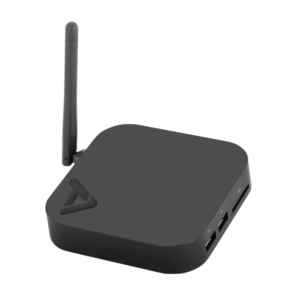Digital signage players come in all shapes and forms. In a nutshell, they are small computers that let you show digital content on a screen.
So how do they work?
Digital signage begins with a content management system (or CMS). This is software that lets you create presentations for your screens, integrating different types of media from images and video to social media and RSS feeds. Once content has been created, you will need a way to upload it to a screen or network of screens. This is where a digital signage player comes in. Players are small computers that connect to the back of screens, usually via HDMI. Digital signage software can then be used to talk to the player and project content on your screen(s).
Are there different types of player?
Digital signage players vary a lot in size, operating system, power and price. Android-based players are often the smallest, ranging from the size of a memory-stick to small boxes that you can hold in one hand. As a rule of thumb, Windows-based players are the largest, reaching the size of a small computer. For convenience, smaller players tend to be favoured as they can be fitted neatly away behind the back of a screen.
In recent years, the technical specs of media players have increased while their prices have continued to fall. You can pick up an entry-level player for as little as £40 while more sophisticated devices can cost up to £1,000. For everyday use in an environment such as a school or retail location, it is worth avoiding the cheapest of models for the sake of reliability, but high spec models are unnecessary too. As the popularity of digital signage grows, different types of players have begun to emerge, for example, using a Chrome OS, or based on the Raspberry Pi.
Why invest in a digital signage player?
The alternative to using a media player for digital signage is plugging in your laptop or computer to a screen. While this might be manageable for one off events (for example, attending a trade show and using a screen on your stand), for regular use this is impractical. Most of the time, screens are unattended, whether they’re in corporate offices, retail spaces or schools. The advantage of a media player is that it can be positioned behind a screen, out of sight. Owners need not worry about them being stolen or damaged.
A green technology
Investing in a digital signage player is a brilliant way of reinventing your old TV screens. The most expensive cost associated with digital signage is the price of the screen itself, with players and software generally being affordable. If you’re a business owner or a school with disused flat screens lying around, plug in a media player and you can breathe new life into your old tech, creating fresh content on a CMS. Android digital signage players in particular are energy efficient too, using approximately £7 in electricity a year.
Digital signage players are the key to displaying engaging, multi-media content on your screens. Create content. Plug in. Play.

Discover Our Digital Signage Solutions
For more information, visit our Features page.
Why not get in touch to find out more?
Call – 02380 981110 or Email Us – info@troudigital.com
